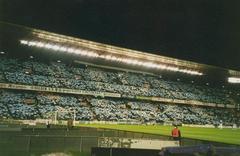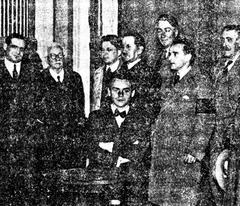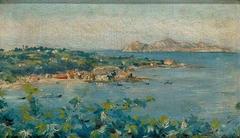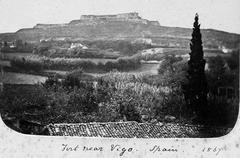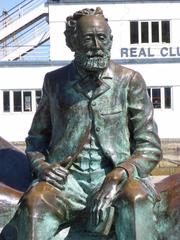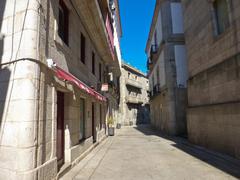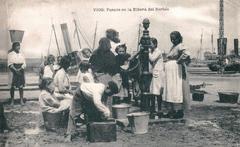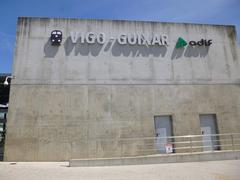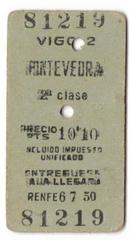
Casa Torre de Ceta y Arines: Visiting Hours, Tickets, and Historical Significance in Vigo, Spain
Date: 04/07/2025
Introduction
Casa Torre de Ceta y Arines, located in the heart of Vigo’s historic Casco Vello, stands as a testament to the city’s noble past and architectural evolution. As one of the oldest and most emblematic civil buildings in Vigo, it offers visitors a unique perspective on the city’s maritime heritage, blending medieval defensive features with Renaissance artistry. This comprehensive guide details the site’s historical background, architectural highlights, current visiting hours, ticketing information, accessibility, travel tips, and nearby attractions to help you plan a rewarding visit (Concello de Vigo; Turismo de Vigo).
Table of Contents
- Introduction
- Historical Origins and Significance
- Architectural Evolution and Features
- Visitor Information: Hours, Tickets, Accessibility
- Travel Tips and Nearby Attractions
- Frequently Asked Questions (FAQs)
- Conclusion
- References and Further Reading
Historical Origins and Significance
Dating from the late 15th to early 16th centuries, Casa Torre de Ceta y Arines was originally commissioned by the Genoese Ceta family, prominent merchants who played a central role in Vigo’s maritime commerce. The structure later became associated with the Galician Arines and Sarmiento families, reflecting a blend of cosmopolitan and local influences in Vigo’s noble society (Concello de Vigo; Audioguia.org).
Originally conceived as a fortified urban manor, the building’s design offered protection from piracy and coastal incursions while showcasing the wealth and status of its owners. Over centuries, Casa Torre de Ceta y Arines has witnessed major phases of Vigo’s urban, social, and political development, earning recognition as a Monumento Histórico-Artístico (Historic-Artistic Monument) in 1946 (Audioguia.org; Wikipedia).
Architectural Evolution and Features
Medieval Foundations
The original structure featured a robust tower-like form constructed from thick granite masonry, narrow defensive windows, and a simple rectangular plan—elements typical of Galician noble residences designed for both defense and prestige (Galicia Guide). Gargoyles and continuous “recogeaguas” cornices channeled rainwater away from the façade, blending functionality with sculptural detail.
Renaissance Transformations
As external threats diminished in the 16th century, the building transitioned from a purely defensive fortress to a more refined Renaissance residence. Decorative stone coats of arms, including the distinctive Genoese cross of the Ceta family and Galician heraldry of the Arines family, were added to the façade. The main entrance was reimagined with a prominent semicircular arch, a hallmark of Renaissance civic architecture (Patrimonio Galego).
Restoration and Adaptive Reuse
Throughout its history, Casa Torre de Ceta y Arines underwent subdivision and various uses, from noble manor to tenement and commercial premises. A major restoration led by architect Alfonso Penela between 1993 and 1998 carefully preserved historic elements while adapting the site for cultural events and exhibitions. Today, the building is home to the Instituto Camões, reinforcing historic ties between Vigo and Portugal (Faro de Vigo; Consorcio Casco Vello Vigo).
Visitor Information: Hours, Tickets, Accessibility
- Location: Rúa Cánovas del Castillo, 3, Vigo (Praza de Almeida, Casco Vello) (Google Maps)
- Visiting Hours: As of July 2025, open Tuesday to Sunday, 10:00 AM – 2:00 PM and 5:00 PM – 8:00 PM; closed Mondays and some public holidays (Vigo Tourism).
- Tickets: General admission is free. Special exhibitions or guided tours may require a nominal fee (€2–€5). Check the official tourism website for current Casa Torre de Ceta y Arines tickets and schedules.
- Accessibility: The ground floor is wheelchair accessible; upper floors may present challenges due to the historic structure. Accessible restrooms are available.
- Guided Tours: Available in Spanish and Galician; English tours for groups by request. Contact the Vigo Tourist Office to arrange.
- Photography: Non-flash photography for personal use is permitted; tripods and commercial shoots require authorization.
- Facilities: Public restrooms are available; no cloakroom or dedicated gift shop.
Travel Tips and Nearby Attractions
- Getting There: Easily reached on foot from central Vigo, with nearby bus and train connections (Vitrasa website).
- Best Times to Visit: Weekday mornings and off-peak seasons are quieter. Spring and early autumn offer the best weather.
- Nearby Sites: Pair your visit with the Concatedral de Santa María, Mercado da Pedra, Museo de Arte Contemporáneo (MARCO), and the vibrant Old Town alleys (Casco Vello Vigo).
- Dining: Numerous cafés and taverns nearby serve Galician specialties.
- Shopping: Explore artisan shops in Casco Vello and the Mercado da Pedra for local crafts.
Frequently Asked Questions (FAQs)
Q: What are the Casa Torre de Ceta y Arines visiting hours?
A: Open Tuesday to Sunday, 10:00 AM – 2:00 PM and 5:00 PM – 8:00 PM. Closed Mondays and holidays.
Q: Is there an entrance fee?
A: General entry is free. Special exhibitions or guided tours may have a small fee.
Q: Is the building accessible to wheelchair users?
A: The ground floor is accessible; upper floors may be limited.
Q: Are guided tours available in English?
A: English tours may be arranged for groups upon request.
Q: Can I take photographs inside?
A: Non-flash photography for personal use is allowed.
Q: Where can I find updated visitor information?
A: Check the official Vigo tourism website for the latest details.
Conclusion
Casa Torre de Ceta y Arines remains a powerful symbol of Vigo’s historical and architectural legacy. Its blend of medieval fortification and Renaissance refinement, set in the atmospheric Casco Vello, invites visitors to step into the city’s storied past. As a cultural hub, it regularly hosts exhibitions, workshops, and special events that highlight Vigo’s enduring ties to the Atlantic world.
To enrich your visit, consult the latest information on hours and ticketing, consider joining a guided tour, and explore nearby historical landmarks. For a deeper experience, download the Audiala app for self-guided tours and audio content, and follow us for updates on Vigo’s cultural scene.
References and Further Reading
- Concello de Vigo – Casa Ceta y Arines
- Turismo de Vigo – Casa Torre de Ceta y Arines
- Patrimonio Galego – Casa Torre de Ceta y Arines Vigo
- Faro de Vigo – Casa Ceta y Arines Restauración
- Consorcio Casco Vello Vigo – Las Casas de Ceta y de Pazos y Figueroa
- Google Maps – Casa Torre de Ceta y Arines Location
- Vigo Tourism Official – Casa Torre De Ceta Y Arines
- Audioguia.org – Casa Torre de Ceta y Arines
- Audiala App – Guided Tours Vigo

